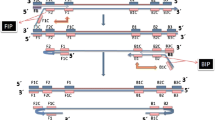Abstract
Leptospirosis is a zoonotic disease caused by pathogenic spirochetes from the genus Leptospira, which includes 20 species and more than 300 serovars. Canines are important hosts of pathogenic leptospires and can transmit the pathogen to humans via infected urine. Here, we report the phenotypic and molecular characterization of Leptospira interrogans isolated from Canis familiaris in Southern Brazil. The isolated strain was characterized by variable-number tandem-repeats analysis as L. interrogans, serogroup Icterohaemorrhagiae. In addition, the isolate was recognized by antibodies from human and canine serum samples previously tested by microscopic agglutination test. Ultimately, the expression of membrane-associated antigens (LipL32 and leptospiral immunoglobulin-like proteins) from pathogenic leptospires using monoclonal antibodies was detected by indirect immunofluorescence assay. In conclusion, identification of new strains of Leptospira can help in the diagnosis and control of leptospirosis.


Similar content being viewed by others
References
Adler B, de la Pena MA (2010) Leptospira and leptospirosis. Vet Microbiol 140:287–296
Benito Calavia JR, Montejo BM, Pumarola T et al (1997) [Leptospirosis. Review of 11 cases]. Enferm Infecc Microbiol Clin 15:306–309
Cerri D, Ebani VV, Fratini F et al (2003) Epidemiology of leptospirosis: observations on serological data obtained by a “diagnostic laboratory for leptospirosis” from 1995 to 2001. New Microbiol 26:383–389
Choy HA, Kelley MM, Chen TL et al (2007) Physiological osmotic induction of Leptospira interrogans adhesion: LigA and LigB bind extracellular matrix proteins and fibrinogen. Infect Immun 75:2441–2450
Ciceroni L, Stepan E, Pinto A et al (2000) Epidemiological trend of human leptospirosis in Italy between 1994 and 1996. Eur J Epidemiol 16:79–86
Faine S, Adler B, Bolin C, Perolat P (1999) Leptospira and leptospirosis, 2nd edn. MediSci, Melbourne, p 272
Fernandes CP, Seixas FK, Coutinho ML et al (2007) Monoclonal antibodies against LipL32, the major outer membrane protein of pathogenic Leptospira: production, characterization, and testing in diagnostic applications. Hybridoma (Larchmt) 26:35–41
Goldstein RE (2010) Canine leptospirosis. Vet Clin North Am Small Anim Pract 40:1091–1101
Haake DA, Chao G, Zuerner RL et al (2000) The leptospiral major outer membrane protein LipL32 is a lipoprotein expressed during mammalian infection. Infect Immun 68:2276–2285
Jorge S, Monte LG, Coimbra MA et al (2012) Detection of virulence factors and molecular typing of pathogenic Leptospira from capybara (Hydrochaeris hydrochaeris). Curr Microbiol 65:461–464
Klaasen HL, Molkenboer MJ, Vrijenhoek MP et al (2003) Duration of immunity in dogs vaccinated against leptospirosis with a bivalent inactivated vaccine. Vet Microbiol 95:121–132
Langston CE, Heuter KJ (2003) Leptospirosis. A re-emerging zoonotic disease. Vet Clin North Am Small Anim Pract 33:791–807
Levett PN (2001) Leptospirosis. Clin Microbiol Rev 14:296–326
Majed Z, Bellenger E, Postic D et al (2005) Identification of variable-number tandem-repeat loci in Leptospira interrogans sensu stricto. J Clin Microbiol 43:539–545
Martins G, Lilenbaum W (2013) The panorama of animal leptospirosis in Rio de Janeiro, Brazil, regarding the seroepidemiology of the infection in tropical regions. BMC Vet Res 9:237
Mayer-Scholl A, Luge E, Draeger A et al (2013) Distribution of Leptospira serogroups in dogs from Berlin, Germany. Vector Borne Zoonotic Dis 13:200–202
Miraglia F, de Morais ZM, Dellagostin OA et al (2012) Molecular and serological characterization of Leptospira interrogans serovar Canicola isolated from dogs, swine, and bovine in Brazil. Trop Anim Health Prod 45:117–121
Monte LG, Conceicao FR, Coutinho ML et al (2011) Monoclonal antibodies against the leptospiral immunoglobulin-like proteins A and B conserved regions. Comp Immunol Microbiol Infect Dis 34:441–446
Monte LG, Jorge S, Xavier MA et al (2013) Molecular characterization of virulent Leptospira interrogans serogroup icterohaemorrhagiae isolated from Cavia aperea. Acta Trop 126:164–166
Oliveira LC, Araujo RR, Alves CR et al (2010) Seroprevalence and risk factors for canine visceral leishmaniasis in the endemic area of Dias D’Avila, State of Bahia, Brazil. Rev Soc Bras Med Trop 43:400–404
Picardeau M (2013) Diagnosis and epidemiology of leptospirosis. Med Mal Infect 43:1–9
Acknowledgments
The authors are grateful to Conselho Nacional de Desenvolvimento Científico e Tecnológico (CNPq) and Fundação de Amparo à Pesquisa do Estado do Rio Grande do Sul (FAPERGS).
Conflict of interest
The authors certify that they have no potential conflicts of interest.
Author information
Authors and Affiliations
Corresponding author
Additional information
Sérgio Jorge and Leonardo G. Monte have contributed equally to the experimental work.
Rights and permissions
About this article
Cite this article
Jorge, S., Monte, L.G., De Oliveira, N.R. et al. Phenotypic and Molecular Characterization of Leptospira interrogans Isolated from Canis familiaris in Southern Brazil. Curr Microbiol 71, 496–500 (2015). https://doi.org/10.1007/s00284-015-0857-z
Received:
Accepted:
Published:
Issue Date:
DOI: https://doi.org/10.1007/s00284-015-0857-z




